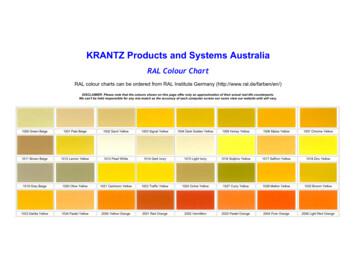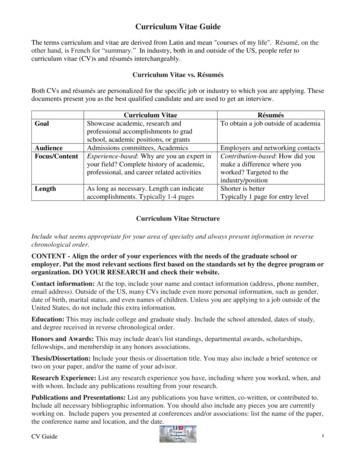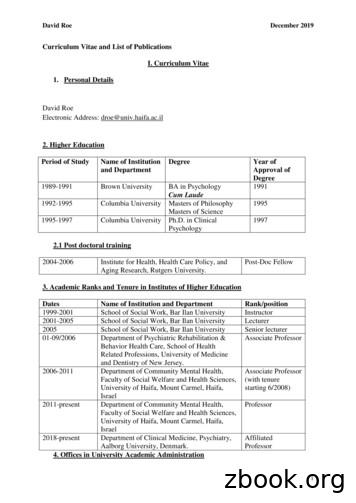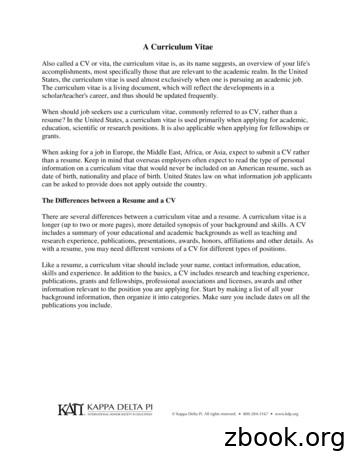Curriculum Vitae Michael Brown - Department Of Geology
Curriculum VitaeMichael BrownNotarization. I have read the following and certify that this curriculum vita is a current and accurate statement of myprofessional record.Signature:Date: 1 January 2021
Curriculum VitaeMichael Brown1. PERSONAL chael BrownLaboratory for Crustal Petrology, Department of Geology, University of Maryland, College Park, MD 207424211, USA; ( 1) 3014054080; mbrown at umd.edu; www.geol.umd.eduMarch 19, 1947, Hayes, Middlesex, UKWife (Jennifer Frances); children (Matthew James, 1980; Thomas Michael, 1985; and, Sarah Jane, 1986)U.S. Citizen/British CitizenUniversity EducationBA HonsPhDGeography and Geology (with subsidiary Chemistry and Political Institutions), University of Keele, UK, 1969University of Keele, UK (1975 graduation), for a thesis entitled “The Petrogenesis of the St. Malo MigmatiteBelt, North‑Eastern Brittany, France”, successfully defended Fall 1974Professional Positions1990 to present3/1/90 to present3/1/90 to 6/30/117/1/02 to present9/1/98 to 9/25/001984 to 199012/9/88 to 2/28/904/30/84 to 2/28/909/1/86 to 2/28/901972 to 19849/1/82 to 4/29/849/1/79 to 8/31/821/1/75 to 8/31/799/1/72 to 12/31/741969 to 19721970 to 1971UNIVERSITY OF MARYLAND, USADepartment of GeologyProfessor of GeologyChair of Department (appointed 1990, reappointed 1995, 2000, 2005 and 2010)Earth System Science Interdisciplinary CenterAffiliate ProfessorInterim Director – concurrent appointment with Chair of DepartmentKINGSTON UNIVERSITY, UKSchool of Geological SciencesProfessor of GeologyHead of SchoolFaculty of ScienceAssociate Dean (Academic Affairs) – concurrent appointment with Head of SchoolOXFORD BROOKES UNIVERSITY, UKDepartment of Geology & Physical SciencesActing Head of DepartmentPrincipal Lecturer in GeologySenior Lecturer in GeologyLecturer in Structural GeologyUNIVERSITY OF KEELE, UKDepartment of GeologyPart-time demonstrator (teaching assistant) in Geology laboratory classesVisiting Appointments2019201820142013199919931990 to 1992Visiting Professor, Curtin University, Western AustraliaVisiting Professor, ETH-Zurich, SwitzerlandVisiting Research Fellow, Curtin University, Western AustraliaVisiting Researcher, Johannes Gutenberg-Universität Mainz, GermanyVisiting Professor, Universidade do Estado do Rio de Janeiro, BrazilVisiting Lecturer, Kyoto University, JapanVisiting Professor, Kingston University, UKBrown: Page 2 of 38
Other Appointments2014 to present2014 to present2010 to present2015 to 20202011 to 2020Associate Director, Center for Global Tectonics, China University of Geosciences, Wuhan, P.R. ChinaHonorary Professor, China University of Geosciences, Wuhan, P.R. ChinaMember, International Precambrian Research Centre of China, Beijing, P.R. ChinaDirector of the Consulting Committee, School of Earth and Space Sciences, Peking UniversityPartner Investigator, ARC Centre of Excellence for Core to Crust Fluid Systems (CCFS), MacquarieUniversity, 05Distinguished Geologic Career Award for 2021, Mineralogy, Geochemistry, Petrology & VolcanologyDivision, Geological Society of AmericaFellow, American Geophysical UnionPlenary Lecturer, 36th International Geological Congress, Delhi, India (cancelled due to Covid-19)51st Hallimond Lecturer, Mineralogical Society of Great Britain and IrelandPresident, Mineralogical Society of AmericaCollins Medal, Mineralogical Society of Great Britain and IrelandAntarctic Service MedalJohn Sacheverell A'Deane Coke Medal, The Geological Society (London, UK)Professional and Learned SocietiesThe Geological Society, Fellow (1972, FGS); Chartered Geologist (1990–2018)Mineralogical Society of Great Britain and Ireland, Member (1980)American Geophysical Union, elected Fellow (2020; Member since 1986)Geological Society of America, elected Fellow (1993; Member since 1987)Mineralogical Society of America, elected Fellow (1999; Member since 1990)European Geophysical Union, Member (2003; EGS Member since 1998)Geochemical Society, Member (2000)Career SummaryAccomplishments in research and related activitiesI am an internationally recognized leader in metamorphic geology, with an emphasis on crustal melting, petrogenesis ofgranulites (including UHT metamorphism) and eclogites (including UHP metamorphism), and metamorphism and tectonics.My research uses observations and laboratory data in petrology and structural geology, integrated with those fromgeochemistry, geochronology and numerical modeling, to investigate orogenic processes at all scales, providing originalcontributions to and insight about heat and mass transfer and secular change. In Google Scholar my citation count is 13,550, my h-index is 67 and my i10-index is 143.My research has: established the petrogenesis of upper amphibolite and granulite facies migmatites by anatexis, produced the firstquantitative P-T-t paths from migmatite terranes, determined petrogenetic relationships between migmatites andleucogranites, and elucidated the polyphase nature of leucogranite complexes (Brown, 1979, 1983; Brown et al., 1981;Jones & Brown, 1990; Brown & D'Lemos, 1991; Pressley & Brown, 1999; Milord et al., 2001; Solar & Brown, 2001;Johnson et al., 2003, 2004; Korhonen et al., 2010a, 2015; Yakymchuk et al., 2015a; Brown, C. et al., 2016); contributed to a comprehensive understanding of Neoproterozoic (Cadomian) magmatism in the northern ArmoricanMassif (Brown et al., 1980; Topley et al., 1982; Strachan et al., 1989; Brown et al., 1990; Power et al., 1990; Topley et al.,1990; D'Lemos & Brown, 1993); determined the inter-relationship between tectonics and magmatism in the Mesozoic Andes of northern Chile (Brown etal., 1993; Grocott et al., 1994; Dallmeyer et al., 1996); demonstrated the role of deformation in the segregation of anatectic melt and furthered our understanding of heat andmass transfer through the crust, with particular emphasis on the role of shear zones and the emplacement of orogenicBrown: Page 3 of 38
leucogranites, and recognized the southern Brittany metamorphic belt as a core complex (D'Lemos et al., 1992; Brown,1994; Brown et al., 1995b; Brown & Dallmeyer, 1996; Brown & Rushmer, 1997; Brown & Solar, 1998a, 1998b, 1999;Brown, 2001, 2005, 2007, 2010a, 2010b, 2013; Marchildon & Brown, 2002); imaged for the first time, using HR X-ray CT, the 3-d form of mesoscopic leucosome, representing former melt flowchannels, in hand samples of migmatite with S L and L S tectonite fabrics, and shown how these relate to the evolvingstrain field during melt flow (Brown, M.A. et al., 1999); and, quantified the 3-d form of leucosome networks at outcropscale in migmatites to understand melt flow through anatectic crust (Marchildon & Brown, 2003; Yakymchuk et al., 2013); characterized ultrahigh temperature metamorphism in the Southern Granulite Terrain of India, the Southern Brasilia Beltin Brazil and the Eastern Ghats Province in India (e.g. Brown & Raith, 1996; Raith et al., 1997; Moraes et al., 2002;Baldwin et al., 2005, 2007; Baldwin & Brown, 2008; Korhonen et al., 2011, 2013a, b, 2014; Mitchell et al., 2019); demonstrated that the Ryoke–Sambagawa paired metamorphic belts were not formed in situ, but were juxtaposedsubsequently by tectonic processes (Brown, 1998a, b, 2010); characterized the secular evolution of subduction and plate tectonics using the crustal record of metamorphism; proposeddistinct geodynamic regimes in Earth’s history based on secular change in metamorphism, and linked these to secularcooling of Earth’s mantle, major surface erosion events and the supercontinent cycle (Brown, 2006, 2007a, 2008, 2009,2014; Brown & Johnson, 2018, 2019a, b; Holder et al., 2019; Sizova et al., 2010, 2012, 2014; Sobolev & Brown, 2019;Brown et al., 2020b); investigated closed vs open system processes in crustal anatexis and quantified the behavior of accessory minerals duringmelting and crystallization (Brown & Korhonen, 2009; Korhonen et al., 2010b; Yakymchuk & Brown, 2014a, b, 2019); been instrumental in establishing the tectonic mode of the Archean Eon prior to the establishment of stable subductionand the emergence of plate tectonics, and in determining the petrogenesis of the tonalite–trondhjemite–granodiorite suiteof rocks (Johnson et al., 2012, 2014, 2016, 2017, 2019; Brown, 2015; Sizova et al., 2015, 2018; Brown et al., 2020a); and, contributed to a better understanding of fluid evolution and melt generation during UHP metamorphism of continentalcrust, with particular emphasis on the role of dehydroxylation of nominally anhydrous minerals during exhumation (Wanget al., 2016, 2017, 2018, 2020; Xia et al., 2018).Major leadership roles in the research communityI proposed and established the Metamorphic Studies Group in the UK (1981; a Specialist Group of the Geological Societyand the Mineralogical Society of Great Britain and Ireland), the Journal of Metamorphic Geology (1982; BlackwellPublishing; now Wiley, Chichester, UK) and the IAVCEI Commission on Granites (1992–1993; International Association ofVolcanology and Chemistry of the Earth's Interior). I was Co-leader of the International Geological Correlation ProgramProject 235 on “Metamorphism and Geodynamics” (1985–1990), General Chair of the Organizing Committee for the HuttonIII Symposium on the “Origin of Granites and Related Rocks” at the University of Maryland, USA, in 1995, and Chair ofthe Organizing Committee for the Granulites & Granulites 2006 Conference held at the University of Brasília, Brazil (thefirst in a triennial series). I was also a member of the co-ordinating group for the Integrated Solid Earth Sciences forumsconcerning setting priorities for research and education in the solid Earth sciences (2002–2006; sponsored by the US NSF).Teaching profileMy approach to education is innovative even though it is based on traditional lecture/laboratory/seminar/tutorial teachingmethods. I stress the importance of personal observation and interpretation in the classroom and in the field, and I foster aquestioning attitude during discussion, particularly with respect to published work.At Oxford Brookes University, my main teaching responsibilities included courses in metamorphic petrology, structuralgeology and tectonics, the year 2 mapping training and structural geology field course and the year 3 hard‑rock option fieldcourse. At various times I also taught physical geology, petrogenesis, map work, first year fieldwork and introductorygeology for Civil Engineers. I supervised undergraduate independent mapping projects (cf. senior thesis), and supervisedfour graduate students to successful completion of PhDs. At Kingston University, my teaching responsibilities includedcourses in metamorphic geology to all 3 years of the BSc Honors Geology program; in addition, I took a tutorial group ineach year of the Course, and taught the first-year field course. I supervised four graduate students to successful completionof PhDs. At the University of Maryland, my main teaching responsibilities included courses in undergraduate and graduatelevel petrology, and in Earth evolution and tectonics. Since 1997 I have taught the undergraduate capstone Honors seminarand more recently I have taught a graduate class on The Precambrian. I advised both undergraduate (four senior thesiscompletions) and graduate students in research (three PhD and five MS completions), and I have mentored six post-doctoralResearch Associates and a number of visiting scientists.Brown: Page 4 of 38
Achievements in management/administrationOver a 29-year period, I demonstrated administrative effectiveness as Head or Chair of Department at Oxford BrookesUniversity, Kingston University and the University of Maryland, and through service to the Institution of Geologists, theGeological Society, the Mineralogical Society of Great Britain and Ireland, the American Geophysical Union, theGeological Society of Washington and the Mineralogical Society of America.At both Oxford Brookes University, as Acting Head of the Department, and Kingston University, as Head of School, I wasresponsible for the provision of academic leadership, and the management of the teaching, research, technical and secretarialstaff, the laboratories and the financial resources. At the University of Maryland, as Chair, I was responsible for thedevelopment of strong undergraduate and graduate programs in Geology and raising the national and international reputationof the Department, which was not ranked among the best 170 graduate programs in Geology in 1990. Under my leadershipthe Department increased the number of faculty by 50%, raised the level of research grant and contract support per yearapproximately eightfold, enlarged the Graduate Program in parallel with more rigorous standards for entry, and stabilizedthe number of undergraduate majors. When I stepped down as Chair in 2011, the Department’s graduate programs ranked14th nationally in Geology (NRC) and 7th nationally in Geochmistry (US News and World Report).External ServiceWhile based in the UK I served on the Council of the Geological Society (1980–1983) and the Mineralogical Society(1985–1988), and on many of their committees, and committees of the Institution of Geologists. I was Secretary (1980–1984) and Chairman (1985–1988) of the Metamorphic Studies Group, Subject Editor (Metamorphic Petrology, 1981–1986)and Advisory Editor (1998–2004) for the Journal of the Geological Society, and founder and Editor of the Journal ofMetamorphic Geology (1982–2019). I served on the Council for National Academic Awards (CNAA) Combined Studies(Science) Board and Committee for Physical Sciences. I represented the National Advisory Body (NAB) on the UniversityGrants Committee (UGC) Earth Sciences Review National Committee, and represented the Committee of Heads on theNational Advisory Body (NAB) Earth Sciences Review Committee. (In the UK, the NAB disbursed Government funding inthe Polytechnic sector until 31 March 1989, and the UGC disbursed Government funding in the University sector until 31March 1989.) In April 1989, the Polytechnics and Colleges Funding Council (PCFC) replaced the NAB, and in August1989, I became a member of the Science Programme Advisory Group.While based in the USA I have served on the Council of the Geological Society of Washington (1991–1992 and 2011), as amember of the American Geophysical Union (AGU) 75th Anniversary Planning Committee (1990–1994), as SpringProgram Chair for the Volcanology, Geochemistry and Petrology Section of the AGU (2002–2004), as a member of theAGU Meetings Committee (2004–2007) and Chair of the Program Committee for the AGU Joint Assemblies in Spring 2006and 2007, and as a member of the AGU Hess Medal Committee (2013–2017). I have been a member of the Committee onManagement of the Mineralogical Society of America (1995–1998), the Nominating Committee for Officers (1998–2001),the Nominating Committee for Fellows (2004–2007, Chair 2005–2007), and the Financial Advisory and Audit Committee(2013–2016). I was a member of the Executive Committee of the AGU Board of Heads and Chairs of Earth and SpaceScience Departments (2000–2003). In addition to founding the Journal of Metamorphic Geology, I was an editor of thejournal for 37 years (1982–2019). I am a former member of the Geology Editorial Board, a former Advisory Editor of theJournal of the Geological Society, London (1998–2004), a former member of the Geological Society, London, BooksEditorial Committee (2005–2011), and a former member of the Journal of the Virtual Explorer Editorial Board. I am amember of the Advisory Board of the International Association for Gondwana Research (2009–present). I was VicePresident of the Mineralogical Society of America for 2017; in this role I was a member of Council, a member of theExecutive, Management, Long-term Planning, and Financial Advisory and Audit Committees, Chair of the Committee onCommittees, and Publications Director. I was President of the Mineralogical Society of America for 2018; in this role Ichaired the Council, and the Executive, Management, and Long-term Planning committees, and I was a member of theFinancial Advisory and Audit Committee. In 2019 I was Past President of the Mineralogical Society of America; in this roleI chaired the Meetings Committee, and I was a member of the Council, the Executive, Management, and Long-termPlanning Committees.2.RESEARCH, SCHOLARLY, AND CREATIVE ACTIVITIESBrown: Page 5 of 38
2.1.Books*Denotes a graduate student author; † denotes a Post-doctoral Research Associate author.Books Authored1. Roach, R.A, Topley, C.G., Brown, M., *Bland, A.M. and *D'Lemos, R.S., 1991. Outline and Guide to the Geology of Guernsey. GuernseyMuseum Monograph No. 3, Guernsey Museum & Art Gallery, 102 pp.Books/Volumes Edited1. Ashworth, J.R. and Brown, M., 1990. High‑temperature Metamorphism and Crustal Anatexis. Unwin Hyman, 407 pp.2. Brown, M., Candela, P.A., Peck, D., Stephens, W.E., Walker, R.J. and Zen, E., 1996. Origin of Granites and Related Rocks. GeologicalSociety of America Special Paper, 315, 361 pp.3. Brown, M. and Rushmer, T., 2006. Evolution and Differentiation of the Continental Crust. Cambridge University Press, 553 pp.4. Sawyer, E.W. and Brown, M., 2008. Working with Migmatites. Mineralogical Association of Canada, Short Course Series, Vol. 38, 158 pp.Chapters in Books1. Brown, M. and Phadke, A.V., 1983. High temperature reactions in pelitic gneiss from Precambrian Sausar metasediments of the Ramakonaarea, Chindwara District, Madhya Pradesh (India): Definition of the exhumation P‑T path and the tectonic implications. In: Phadke,A.V. and Pansalkar, V.G. (eds), Prof. Kelkar Memorial Volume, Indian Society of Earth Scientists, Poona, pp. 61‑96.2. Brown, M., 1983. The petrogenesis of some migmatites from the Presqu'ile de Rhuys, southern Brittany, France. In: Atherton, M.P. andGribble, C.D. (eds), Migmatites, Melting and Metamorphism, Shiva Publishing Limited, Nantwich, pp. 174‑200.3. *Jones, K.A. and Brown, M., 1989. The metamorphic evolution of the Southern Brittany migmatite belt, France. In: Daly, J.S., Cliff, R.A. andYardley, B.W.D. (eds), Evolution of Metamorphic Belts, Geological Society, London, Special Publications, 43, 501‑505.4. Brown, M., Power, G.M., Topley, C.G. and *D'Lemos, R.S., 1990. Cadomian magmatism in the North Armorican Massif. In: D'Lemos, R.S.,Strachan, R.A. and Topley, C.G. (eds), The Cadomian Orogeny. Geological Society, London, Special Publications, 51, 181‑213.5. Power, G.M., Brewer, T.S, Brown, M. and Gibbons, W., 1990. Late Precambrian foliated plutonic complexes of the Channel Islands and LaHague ‑ Early Cadomian plutonism. In: D'Lemos, R.S., Strachan, R.A. and Topley, C.G. (eds), The Cadomian Orogeny. GeologicalSociety, London, Special Publications, 51, 215‑229.6. Topley, C.G., Brown, M., *D'Lemos, R.S., Power, G.M. and Roach, R.A., 1990. The northern igneous complex of Guernsey. In: D'Lemos,R.S., Strachan, R.A. and Topley, C.G. (eds), The Cadomian Orogeny. Geological Society, London, Special Publications, 51, 245‑259.7. Ashworth, J.R. and Brown, M., 1990. An overview of diverse responses to diverse processes at high crustal temperatures. In: Ashworth, J.R.and Brown, M. (eds), High-temperature Metamorphism and Crustal Anatexis. The Mineralogical Society Series: 2. Unwin Hyman, pp.1‑18.8. Brown, M., 1991. Comparative geochemical interpretation of Permian–Triassic plutonic complexes of the Coastal Range and Altiplano(25o30'‑26o30'S), northern Chile. In: Harmon, R.S. and Rapela, C.W. (eds), Andean Magmatism and its Tectonic Setting. GeologicalSociety of America Special Paper, 265, 157-177.9. Brown, M., 1995. P-T-t evolution of orogenic belts and the causes of regional metamorphism. In: Le Bas, M.J. (ed), Milestones in Geology,Geological Society, London, Memoir No. 16, 67-81.10. Brown, M. and Rushmer, T., 1997. The role of deformation in the movement of granite melt: views from
9/1/72 to 12/31/74 Lecturer in Structural Geology 1969 to 1972 UNIVERSITY OF KEELE, UK Department of Geology 1970 to 1971 Part-time demonstrator (teaching assistant) in Geology laboratory classes Visiting Appointments 2019 Visiting Professor, Curtin University, Western Australia
8002 Signal Brown 8003 Clay Brown 8004 Copper Brown 8007 Fawn Brown 8008 Olive Brown 8011 Nut Brown 8012 Red Brown 8014 Sepia Brown 8015 Chestnut Brown 8016 Mahogany Brown 8017 Chocolate Brown 8019 Grey Brown 8022 Black Brown 8023 Orange Brown 8024 Beige Brown 8025 Pale Brown. 8028 Earth Brown 9001 Cream 9002 Grey White 9003 Signal White
Curriculum Vitae Guide The terms curriculum and vitae are derived from Latin and mean "courses of my life". Résumé, on the other hand, is French for “summary.” In industry, both in and outside of the US, people refer to curriculum vitae (CV)s and résumés interchangeably. Curriculum Vitae vs. Résumés
CV curriculum vitae CV v. resume – Length – Scholarly/scientific. Curriculum Vitae CV curriculum vitae CV v. resume – Length – Scholarly/scientific – Detailed. Curriculum Vitae (CV) Name, title, curren
1 Curriculum Vitae and List of Publications I. Curriculum Vitae 1. Personal Details David Roe Electronic Address: droe@univ.haifa.ac.il 2. Higher Education Year of Approval of Degree Name of Institution Degree and Department Period of Study BA in Psychology 1991 Cum Laude 1989-1991 Brown University Masters of Philosophy 1995 Masters of Science
A Curriculum Vitae Also called a CV or vita, the curriculum vitae is, as its name suggests, an overview of your life's accomplishments, most specifically those that are relevant to the academic realm. In the United States, the curriculum vitae is used
3.0 TYPES OF CURRICULUM There are many types of curriculum design, but here we will discuss only the few. Types or patterns are being followed in educational institutions. 1. Subject Centred curriculum 2. Teacher centred curriculum 3. Learner centred curriculum 4. Activity/Experience curriculum 5. Integrated curriculum 6. Core curriculum 7.
Vita vs. Vitae (pronounced VEE-tye, not VEE-tay) The correct term for the CV is the “curriculum vitae” Latin meaning “[the] course of [my] life” “vitae”is plural for the word “vita” but in the case of curriculum vitae, itis a modifier for the singu
Orosz, Michael, D. 1 CURRICULUM VITAE Michael D. Orosz, Ph.D. June 2015 Home address: 575 South Barrington Avenue, #401 Los Angeles, California 90049 Work address: Information Sciences Institute Viterbi School of Engineering University of Southern California 4676 Admiralty Way, Suite 1001 Marina del Rey, California 90292 mdorosz@isi.edu























